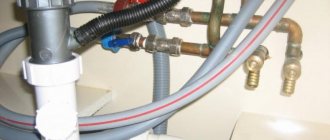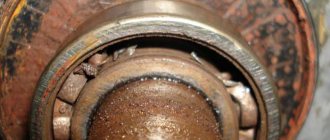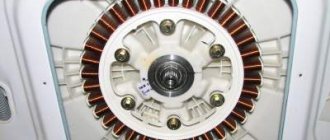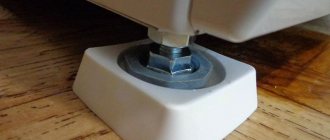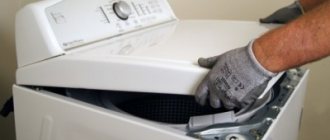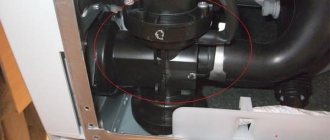Preventative maintenance of any mechanism does not require a lot of money, but significantly extends the period of trouble-free operation of the device. An automatic washing machine is a complex piece of equipment that requires attention.
Reliability during operation depends on the condition of the five main components of the device. This is a tubular electric heater, a receiving tray for detergents, a washing drum and a sealing collar for its hatch. What matters is the appearance of the washing machine and its preparation for storage during non-working periods.
- Removing scale from heaters and hydraulic systems
- Caring for the surface of the washing machine body
- Cleaning the tray from chemical residues
- Cleaning the drum from the inside
- Prevention of the sealing cuff of the hatch
- Preserving the car for winter storage
- Catalog of washing machines with reviews
Removing scale from heaters and hydraulic systems
Depending on the impurities contained in the water, it can be soft when there are few blockages or hard when there are a lot of dissolved salts. In places where moisture is heated and evaporated, a white-gray coating – scale – is deposited.
Are you unplugging your washing machine?
Oh yes! No
Vulnerable components in the washing machine are the heating element and the surfaces of the channels of the internal hydraulic system of the SMA. Enveloping the heater with a coat of salt leads to a decrease in its calorific value, which causes excessive energy consumption. The flow in the system tubes becomes difficult, and the operating conditions of the drain pump become more complicated.
Mechanical cleaning of heating elements
Signs of excessive deposit accumulation include cool water during washing and fragments of petrified salt in the drain filter. If the scale is not removed, the SMA will break.
More precisely, washing will be done with cold water. The efficiency of such washing approaches zero.
Burnt SMA water heater
To get to the tubular heater, you need to follow this order:
- disconnect the machine from the power supply by unplugging the cord from the socket;
- remove the back wall of the case - it is held on by 6 screws;
- disconnect the wires from the heater terminals;
- unscrew the fastening bolts that press the heating element through the seal to the wall of the machine tank;
- remove the tubular structure from the seat.
Remove salt deposits with a plastic or wooden scraper so as not to damage the integrity of the heater itself. First, the metal part of the heater can be kept in a solution of vinegar or citric acid to soften the salt crust. The descaled heating element is mounted in its original place in the reverse order.
Expert opinion
I work in the household appliance repair industry. Extensive experience in restoring washing machines and dishwashers.
Ask a Question
This kind of prevention should be performed only if you are confident in your abilities. This job requires certain skills and experience. It is highly undesirable to do this!
Removing salts from the system by dissolution
To clean the internal waterways of the machine, you need to empty the drum of the laundry and let the machine run for some time idling with a descaling solution. In this case, industrially produced reagents or improvised substances from the kitchen are used. Procedure:
- Pour 80 g of citric acid into the receiving tray. An alternative is an anti-scale agent for washing machines with additives that protect the rubber parts of the SMA.
- Set the mode for cotton with water heating to 60–90ºС. Greater importance is taken during long breaks in prophylaxis.
- Start the program with the start button.
The frequency of flushing depends on the quality of water treatment and the solvent used. With medium hardness, clean the car 1-2 times a year with a special anti-scale agent, and 3-4 times a year with lemon juice. Cleaning filters and water softeners at the entrance to the SMA reduce the frequency of washing by half, as does the use of washing gels and powders with anti-scale agents included in their composition.
Expert opinion
I work in the household appliance repair industry. Extensive experience in restoring washing machines and dishwashers.
Ask a Question
This is the best prevention for your washing machine! Simple and affordable. Really increases the operating time without repair.
Top common symptoms of malfunctions
A non-professional cannot immediately determine what exactly has gone wrong. But there are signs that may indicate the cause of the malfunction. The most common symptoms and possible causes of breakdowns listed will help with diagnosis.
No. 1: the water in the drum does not heat up
Often this failure is not detected immediately. Most machines behave as if nothing had happened: they start the washing, rinsing, spinning mode. You take the laundry out of the drum and don’t even suspect that all the processes took place in cold water.
At first, housewives note that the quality of washing is deteriorating sharply. Replacing the powder and operating modes of the washing machine does not help
If you encounter such a problem, conduct an experiment: while the washing machine is in active mode at a high temperature, carefully touch the glass of the drum door. It should heat up from the hot water. If this does not happen, most likely the water in the system is not heated.
There may be several reasons for this:
- breakdown of the heating element;
- thermostat failure;
- failure of the electronics - programmer.
Of course, there is also the option of choosing the wrong mode when washing in cold water is provided by the program. Before sounding the alarm, read the instructions and make sure that the mode is selected correctly.
A burnt heating element is a common story in the workshop. People deal with this kind of breakdown very often. Due to a power surge, short circuit or manufacturing defect, the heating element may burn out. The average service life of the heater is about 5 years.
Due to constant heating and cooling, as well as due to the high salt content in tap water, the heater material becomes covered with scale, and this affects its performance. If the heating element is burnt out, only replacing it will help.
If the temperature sensor is broken, the machine behaves differently. The heating element is operational and ready to heat the water, the programmer sets the desired temperature, but the regulator - temperature sensor - gives a false signal that the water has already heated up. Thus, the machine washes in cold water. Most often it needs to be replaced.
If upon inspection of the board no mechanical damage was found, you should try to reflash it. Otherwise, replace
If the problem is software (the firmware has crashed or the board is damaged), the washing machine simply gives the wrong command and the water does not heat up. After the update, the wash is started again and, if the problem persists, the programmer is changed.
No. 2: The washing machine knocks and vibrates
Some washing machines make noise from the first wash. This may be a design feature of the device. This often occurs in older models, when during the spin cycle the washing machine looked like a rocket during launch. Modern washing machines are quiet.
Knocking may be a sign of:
- incorrect installation;
- getting a foreign object between the drum and the tank;
- bearing failure;
- failure of shock absorbers;
- uneven distribution of laundry.
The first thing you should pay attention to is the installation of the washing machine. It is incorrect installation that causes knocking during washing in most cases.
The machine must be level with the floor and stand firmly on it. For adjustment, special legs are provided that allow you to separately adjust the height of each of the support points.
When you don't remove loose change, nails, and paper clips from your pockets before putting your laundry in the wash, you risk breaking your washing machine. The fact is that small things can easily get into the water heating tank through the gap between the tank and the drum.
Experienced repair technicians name another common cause of such damage - a bra underwire. Check pockets carefully, and wash underwear with pits in special bags
Bearings ensure that there is no friction while the drum moves. They also have a service life and most often they fail before other parts. It’s easy to understand that the problem is in the bearings: in addition to knocking, the machine will make a creaking noise. If you hear such sounds, get ready to replace the bearings.
Shock absorbers dampen drum vibrations during rotation. If one of them breaks, it immediately affects the operation of the washing machine. The drum may visually move or tilt.
While driving, the drum swings more strongly, can knock on other parts of the car and behave quite “violently”. This symptom indicates the need for shock absorber repair.
The reason for the knocking, which is not a malfunction, can occur when the laundry in the drum is unevenly distributed, that is, collected on one side. This often happens when washing bed linen in older machine models. This cannot be called a breakdown, rather a feature of the operation that may be the cause of the knocking.
No. 3: water drips from the hatch or flows below
If you notice a puddle under your washing machine, do not rush to grab your head and buy new equipment.
The most common cause of water appearing from the washing machine is:
- failure of the gasket on the supply hose;
- tear of the hatch cuff;
- pipe burst.
These design elements are not that expensive and can be changed quite quickly if you have experience and knowledge in this area. Any depressurization of the joints, of course, leads to a leak. The technician’s task is to detect the source of the leak and eliminate it.
Also, do not panic if water starts flowing directly from the drum or from under the machine while washing the curtains. The fact is that tulle curtains whip up foam very well. The powder for the washing machine does not foam very much, but not in the case of washing tulle
An excess of foam in the drum leads to the fact that it begins to seep through all the slightest cracks and minimal technological holes. The result is a puddle on the floor. If the machine does not leak when washing other things, then this can be attributed to a design feature and add less detergent for washing curtains.
No. 4: water in the drum before or after washing
If, after finishing a full wash cycle, you open the drum and see water there, your machine has a draining problem. During the spin process, all water that can be squeezed out of the laundry must go down the drain.
If this does not happen, you need to look for the cause of the breakdown. Most often this is:
- clogged filter;
- broken pump.
Think about the last time you cleaned your washing machine filter. If you don't know where it is, most likely you already know the cause of the problem. A clogged filter can not only cause inconvenience in the form of water in the drum, but also cause a more serious breakdown - the drain pump.
A breakdown of the drain pump most often ends in its replacement. But repairs are also possible if you contact an experienced technician.
Another problem: water in the drum before turning on. That is, you are going to wash, you open the door and everything is flooded. Rate the quality of this water: is it clean or dirty.
Clean indicates a broken valve in the area where the machine connects to the water supply. The dirty one comes from the sewer. Most likely, the siphon is clogged and the water simply has nowhere to go after washing.
No. 5: washing does not start - no water
The opposite problem is that there is no water. That is, you turn on the washing machine as usual, start the wash cycle, but the wash does not start and an error appears about the lack of water in the system.
If you have checked the water supply in the water supply and also opened the tap, look for the problem elsewhere:
- the supply hose is clogged;
- the intake filter is broken;
- software failure of water supply.
To diagnose a malfunction, you need to disassemble the device, wash each element in the water supply system, install it in place and try to start the wash. If water does not flow, repairs or replacement will have to be made.
No. 6: the washing machine does not respond when turned on
The worst thing for the owner of the machine is the moment when the device stops responding to the power button. The washing machine does not turn on - a housewife’s worst nightmare.
There may be several reasons:
- the power supply burned out;
- the surge protector or socket is broken;
- The firmware has crashed.
Everything related to electrical and electronics must be repaired with extreme caution, and it is better not to undertake it at all if you are not a master. However, anyone with minimal knowledge of the basics of electrical engineering can repair or replace an outlet.
If the power button works, but the wash does not start, you need to look for other reasons. In particular, the fault may lie in the door latch
If the drum is not tightly closed, the protection is triggered and the washing does not start. And if the latch is broken and does not close completely, the selected program cannot start the cycle.
No. 7: the drum does not spin or spins in one direction
If the wash starts, but, looking through the window on the door, you find that the drum is motionless, look for the cause of the washing machine malfunction, most often it is:
- the drive belt is broken;
- the engine broke down;
- a foreign body has gotten between the drum and the tank;
- software failure.
One of these reasons can be detected without even disassembling the equipment. Unplug the appliance and try to manually rotate the drum.
If you can't rotate the drum, something is stuck and preventing movement. If the drum can be turned by hand when it is turned off, you need to disassemble the machine and look for the problem.
If a foreign object interferes with movement, it will be enough to remove it. A more serious breakdown will require more time and money to purchase a new spare part.
Caring for the surface of the washing machine body
Upon completion of the process of refreshing the linen, the SMA must be disconnected from the power supply and wiped with a damp and then a dry cloth to remove any traces of work remaining on it. This is a reasonable precaution, since there is a possibility of current leaks, and water can accidentally get inside the case when it is washed with a wet sponge. The following requirements apply to the compositions used to care for machine panels:
- the active substance of the solution should not be aggressive: alcohol and chlorine-containing reagents should not be used;
- it is necessary to exclude the presence of abrasive particles - they will damage shiny surfaces;
- It is allowed to wash the panels with gel, soap solution using soft rags and brushes.
Removing dirt from crevices is done with a toothbrush or toothpick. The procedure is completed by wiping the machine with a dry towel. Plugging into the socket is delayed until the next wash.
Empty washer body
Cleaning the tray from chemical residues
The container for reagents involved in washing laundry is located on the front panel of the SMA. Gels and powders are naturally absorbed into the solution when the tray is filled with water.
Sometimes some substances remain in the compartments and accumulate. To remove sediment, perform the following procedures to clean the receiving container:
- Remove the tray from the machine by pressing the locking latch while simultaneously pulling the box towards you. If there is no stopper, the compartment is tilted down and pulled out of the niche.
- Fill the container with descaling cleaning solution and leave for an hour. Clean the tray from deposits and rinse with clean water.
- Remove petrified washing powder from the inside of the niche. Here you can use abrasive agents: this part of the machine is hidden from view.
The cleaned container with partitions is installed in its original place. If there is a lock on the tray, a click will be heard when the compartments fit into the niche.
Removing the detergent tray
Reasons for failure of semi-automatic washing machines
- Burnt out contacts, damaged wiring;
- Failure of the timer, motor, temperature sensor, relay, capacitor, transformer;
- Worn brushes;
- Too much water, debris (small objects or laundry) getting into the tank;
- Bushing wear;
- The drive belt has broken or jumped off;
- Loosening at the junction of hoses with centrifuge parts;
- The drain pump housing is damaged;
- The hose or pipe is damaged;
- The lid seals are worn out and the pump is leaking water.
Cleaning the drum from the inside
The working body of the washing machine is made of stainless steel. Red spots may appear on the shiny surface from small metal objects stuck in the holes and crevices of the drum: nails, coins, paper clips. Rust removal is carried out under the following provisions:
- Use a special metal cleaner. It is allowed to use anti-scale agents, baking soda, and citric acid for cleaning. The last reagent in the amount of 100–200 g is poured into the drum, the washing mode is set to 60ºС and scrolled. Another solution recipe: for 2 cups of washing powder – 100 g of bleach.
- Do not use a metal sponge.
Washing machine drum
The use of flammable products to clean the drum is prohibited: alcohol, gasoline, kerosene can flare up from an accidental spark of a static discharge. Mixtures based on strong acids are excluded from the range of detergents.
Prevention of the sealing cuff of the hatch
The rubber device for sealing the door of the washing chamber of the washing machine through which laundry is loaded also requires care. Deposits of dirt particles and cleaning agents accumulate in the spring-loaded cuffs of the seal. If a washing cycle is used for a long time at a temperature <60ºC, mold may form.
Prevention of the hatch cuff:
- bend the edges of the elastic band;
- remove fungal formations with a chlorine-based liquid cleaner - Domestos or Belizna;
- wipe the outer surfaces of the seal, close the door and leave for about half an hour so that the microorganisms die;
- run the washing machine in rinse mode.
You can also treat the rubber cuff with copper sulfate: 30 g per liter of water. The day after wiping, run the SMA using the quick wash program at 30–40ºС. Mold will not appear on the seal if you run the machine once a month for a full cycle using bleach, and wipe the cuff and drum dry after each wash.
Sealing cuff
Preserving the car for winter storage
This procedure is necessary if the SMA is operated in country conditions. The owners move into an apartment, and leave the household appliances until the next season. Preservation involves preparing the vehicle for storage at sub-zero temperatures.
Actions taken:
- Unscrew the filter and drain the water from the hydraulic system;
- remove moisture from the powder receiving container;
- dry the drum and seal with the hatch door open.
In conclusion, a piece of advice. There is no need to neglect the maintenance of an automatic washing machine: its condition is judged by its appearance. The insides also require care: the heating element, the powder receiver, the drum and the sealing collar. Preliminary softening of water will extend the service life of washing equipment - you need to use additives and inlet cleaning filters.
Video
Is it worth doing it yourself?
If you are not in Minsk and cannot call our technician for maintenance, then you can easily do this work yourself. Almost any person who has held a screwdriver in their hands and has an understanding of technology can do it.
But there are also quite obvious disadvantages:
- It takes a long time to do this
- There is a possibility of damage to adjacent nodes
- It is impossible to assess the need to repair a particular component of the washing machine.
Therefore, it is easier and more reliable to call a specialist to carry out maintenance of your washing machine!
